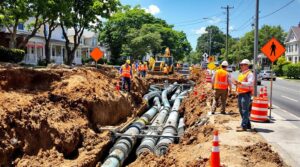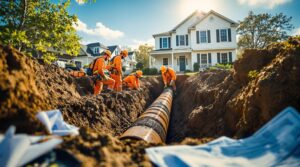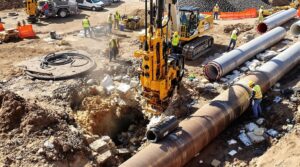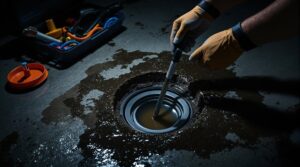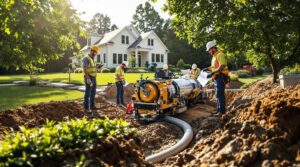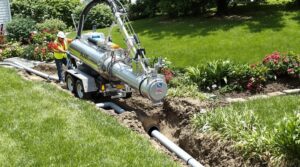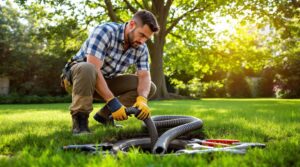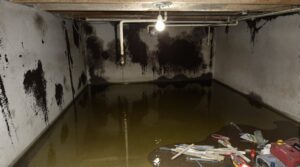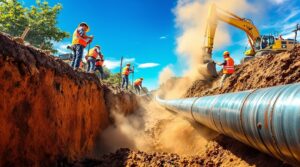Effective sewage pipe cleaning requires specialized equipment, including a pressure washer (minimum 2500 psi, 3 gpm), jetter nozzle, and 50-100 feet of sewer jetting hose. Safe operation demands a two-person team using proper protective gear and maintaining clear communication. The process involves steady nozzle advancement while monitoring water pressure and flow. Monthly preventive cleaning with baking soda solutions helps maintain system health. Professional expertise guarantees ideal results and safety compliance for complex situations.
Key Takeaways
- Use a pressure washer with at least 2500 psi and 3 gpm capacity, equipped with a specialized jetter nozzle for effective pipe cleaning.
- Operate cleaning equipment with a two-person team, ensuring proper safety gear and clear communication throughout the process.
- Start with low pressure and gradually increase while monitoring water flow to prevent damage to vulnerable pipe materials.
- Regular maintenance using baking soda solutions monthly can prevent major blockages and maintain healthy sewage flow.
- Address common blockages like fats, oils, and greases through consistent cleaning schedules and proper waste disposal practices.
Essential Equipment for Pipe Cleaning
Assembling the proper equipment is critical for effective sewage pipe cleaning. A pressure washer rated at minimum 2500 psi with 3 gallons per minute flow capacity serves as the primary tool for addressing serious plumbing problems.
The system requires specific components for peak performance in sewer lines. A specialized jetter nozzle, which typically costs approximately $30, transforms a standard pressure washer into an effective drain cleaning apparatus.
The setup must include 50-100 feet of dedicated sewer jetting hose to reach sufficient depths within the pipe system. A high-pressure ball valve is essential for maintaining precise control over water flow during operation.
Safety considerations mandate the use of protective equipment when dealing with sewage systems. Operators must utilize appropriate gloves and eye protection to guard against hazards associated with high-pressure water operations and potential biological contamination during the cleaning process.
High-Pressure Jetting Techniques
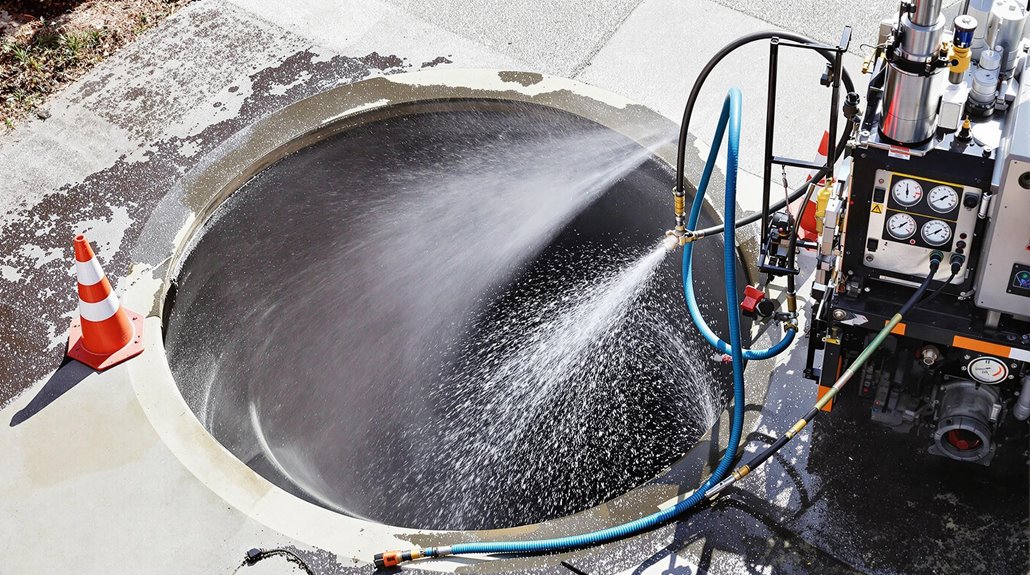
Proper high-pressure jetting technique demands strict adherence to safety protocols and specific operational procedures. The process requires a pressure washer delivering at least 2500 psi with 3 gpm capacity, combined with a specialized jetter nozzle to effectively clear clogged drain lines. A two-person team must coordinate using predetermined signals to maintain control and safety throughout the operation.
- Select appropriate pressure settings based on pipe material, avoiding high pressure on orangeburg or aging galvanized steel lines.
- Position the jetter nozzle at the correct entry point and maintain steady advancement through drain lines.
- Monitor water flow and pressure continuously while coordinating with the second operator.
The high-pressure jetting process not only removes blockages but also provides thorough cleaning of pipe walls, helping restore peak flow capacity.
This technique proves most effective on cast iron and PVC pipes, where the powerful water stream can safely scour the interior surfaces without causing structural damage.
Safe Operation and Best Practices
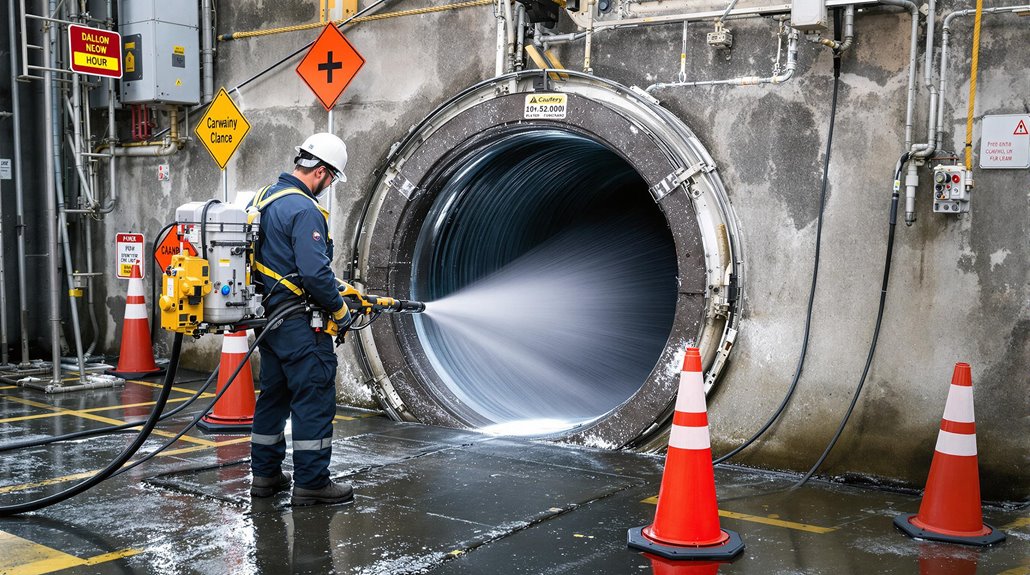
When operating sewage pipe cleaning equipment, strict adherence to safety protocols remains paramount to prevent injuries and exposure to hazardous materials. Proper safety gear, including gloves, goggles, and face masks, must be worn at all times to protect against harmful bacteria and chemical exposure.
| Safety Element | Critical Requirements |
|---|---|
| Personal Protection | Gloves, goggles, face mask |
| Team Communication | Clear signals, constant contact |
| Equipment Operation | Two-person minimum staffing |
| Maintenance Protocol | Regular inspection of all components |
High-pressure equipment operation demands precise coordination between team members. A dedicated two-person system warrants one operator controls the pressure washer while the other manages the hose movement. Before initiating the jetting process, operators must verify proper pressure buildup before opening the ball valve to prevent equipment damage. Regular maintenance checks of jetting equipment, particularly nozzles and hoses, are essential to prevent operational failures that could compromise worker safety or system integrity.
Maintenance Schedule and Prevention
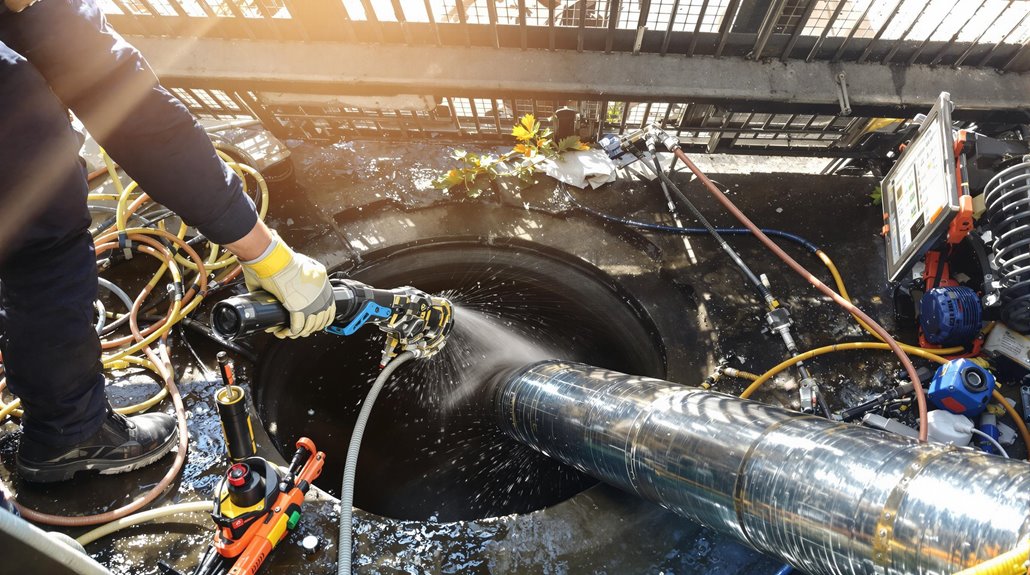
A well-structured maintenance schedule serves as the foundation for long-term sewage pipe health and operational efficiency. Implementing preventive cleaning measures at regular intervals greatly reduces the risk of a clogged sewer system and extends infrastructure longevity.
Professional inspections should be conducted annually, while homeowner-initiated maintenance occurs more frequently through the application of enzyme cleaners and baking soda treatments.
Key maintenance schedule components include:
- Monthly to bi-monthly application of baking soda solutions for pipe wall maintenance
- Quarterly assessment of drain flow rates and potential blockage indicators
- Annual professional inspection and cleaning service, especially for systems over 10 years old
The implementation of high-volume flushing techniques, combined with proper disposal practices, maintains ideal sewage flow.
Regular maintenance prevents the accumulation of non-biodegradable materials and mineral deposits, which commonly cause system failures. This proactive approach to sewer maintenance ultimately proves more cost-effective than reactive repairs to severely compromised systems.
Common Blockages and Solutions
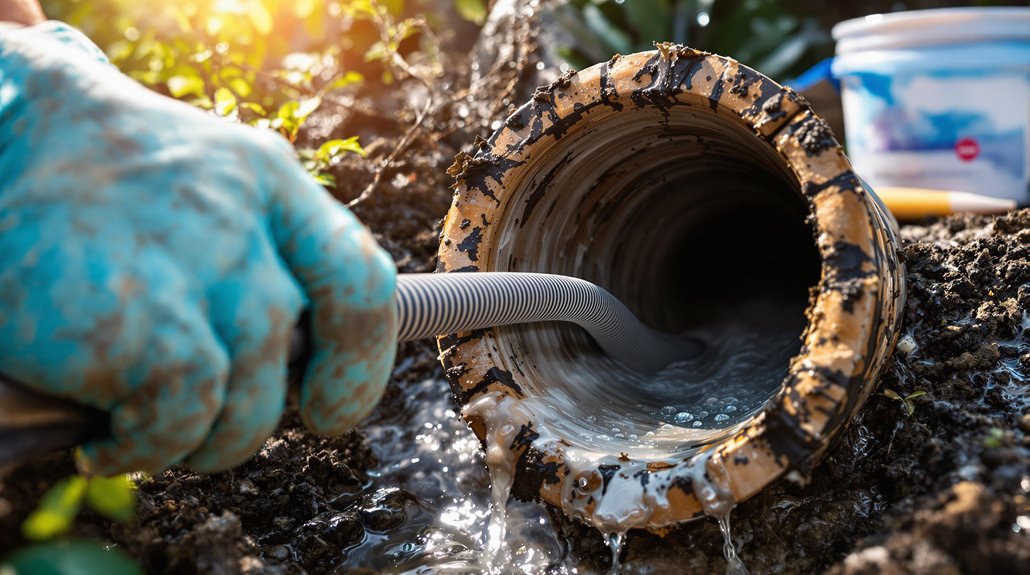
Identifying and addressing common blockages in sewage systems requires understanding the primary culprits that impede proper flow. The accumulation of fats, oils, and greases (FOG) in the main sewer line represents a significant challenge, as these substances adhere to pipe walls and solidify over time, restricting water flow and creating stubborn blockages.
Tree root infiltration poses another serious threat to sewage systems, as roots naturally seek moisture and can penetrate pipe joints, creating both blockages and structural damage.
Additionally, improper disposal of solid materials, including paper towels, multi-ply toilet paper, and hygiene products, frequently leads to system-wide clogs that require professional intervention.
While commercial drain cleaners may provide temporary relief, sustainable solutions include implementing preventive measures such as proper waste disposal practices and utilizing natural cleaning methods like baking soda and vinegar combinations.
Regular maintenance and inspection of sewer lines helps identify potential issues before they escalate into major blockages.
The Benefits Of Consulting A Public Adjuster
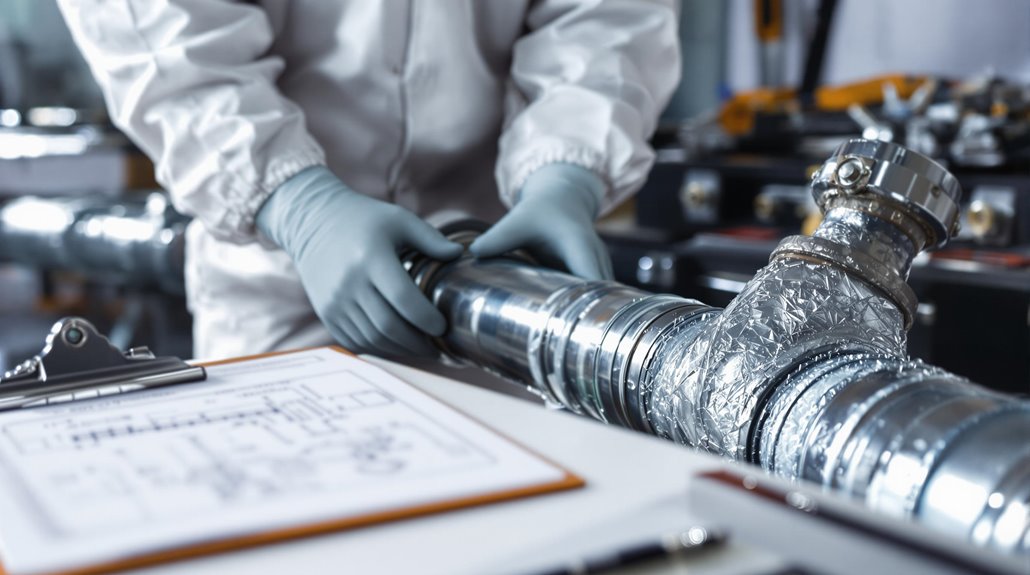
When dealing with major sewage pipe damage that requires an insurance claim, consulting a licensed public adjuster provides critical expertise in documenting and evaluating the full scope of the damage objectively.
Public adjusters streamline the claims process through professional documentation, detailed damage evaluation, and expert policy interpretation, ensuring all damage aspects are properly addressed.
Studies demonstrate that policyholders who engage public adjusters typically receive notably higher settlement amounts, often up to 800% more than those handling claims independently.
Early involvement of public adjuster services is crucial for thorough documentation and preventing potential complications that could limit claim options.
Expertise In Insurance Claims
The expertise of public adjusters provides significant advantages when dealing with sewage pipe damage insurance claims. When Plumbing Systems fail, their specialized knowledge guarantees proper documentation of drain line damage and detailed assessment of repair costs.
Studies indicate that settlements managed by public adjusters typically result in 20-30% higher compensation compared to self-managed claims. They make certain policyholders receive fair coverage for both immediate repairs and potential long-term issues.
- Professional evaluation of policy coverage specific to sewage system damages
- Thorough documentation of affected plumbing components and associated losses
- Strategic negotiation with insurance carriers to maximize claim settlements
Their expertise extends beyond basic claim filing, as they understand complex policy language and insurance regulations. This knowledge proves invaluable when dealing with extensive sewage pipe damage, guaranteeing all aspects of the loss are properly addressed and compensated.
Sudden and accidental events are typically covered by insurance policies, making it essential to document the timing and nature of sewage pipe failures.
Objective Damage Assessment
Professional damage assessment through a public adjuster provides property owners with an unbiased evaluation of sewage pipe deterioration and related structural impacts.
Through systematic documentation and expert analysis, these specialists conduct thorough inspections of sewer system components, identifying both visible and concealed damage patterns.
When drain failure occurs, public adjusters employ standardized assessment protocols to quantify the extent of property damage.
Their objective damage assessment methodology encompasses detailed photographic evidence, extensive documentation of affected areas, and expert evaluation of repair requirements.
This systematic approach guarantees that insurance claims accurately reflect the full scope of damage, from immediate pipe issues to secondary effects on building structures.
Their unbiased expertise helps property owners secure appropriate compensation while maintaining compliance with policy terms and industry standards.
Working on a contingency fee basis, public adjusters typically charge 5-20% of the final settlement amount for their comprehensive damage assessment services.
Streamlined Claim Process
Engaging a public adjuster delivers measurable advantages throughout the insurance claims process for sewage pipe damage.
When issues like slow flushing or tree roots infiltration cause significant problems, public adjusters streamline the settlement process by serving as knowledgeable intermediaries between policyholders and insurance companies. Their expertise typically results in 20-30% higher settlements compared to self-filed claims.
- Professional documentation of damage patterns, including issues beyond simple baking soda remedies
- Extensive assessment of policy coverage and maximum benefit identification
- Expert negotiation with insurance providers to expedite claim resolution
Public adjusters manage complex paperwork, conduct thorough damage evaluations, and present compelling evidence to support claims.
Their specialized knowledge guarantees proper valuation of sewage system damages while reducing the policyholder's stress and time investment in the claims process.
Working with public adjuster fees in Texas are typically capped at 10% of the total claim settlement, ensuring fair compensation for their valuable expertise.
Higher Claim Payouts & Settlements
Statistical evidence demonstrates that consulting a public adjuster for sewage pipe damage claims yields substantially higher settlements, with documented increases ranging from 20% to 50% compared to self-filed claims.
Public adjusters leverage their specialized knowledge of insurance policies and claims procedures to maximize compensation for sewage-related damages.
Their expertise guarantees detailed documentation of all affected areas, including hidden damage that property owners might overlook. Working on a contingency basis, these professionals align their interests directly with achieving ideal claim payouts for their clients.
The adjuster's ability to negotiate effectively with insurance carriers, combined with their thorough understanding of coverage parameters, results in more favorable settlements.
This professional representation not only secures higher claim payouts but also expedites the settlement process, enabling faster restoration of damaged sewage systems.
With organizations like PCAN's vetted network of licensed adjusters, property owners can be assured they're working with professionals who maintain the highest standards of ethics and expertise.
About The Public Claims Adjusters Network (PCAN)
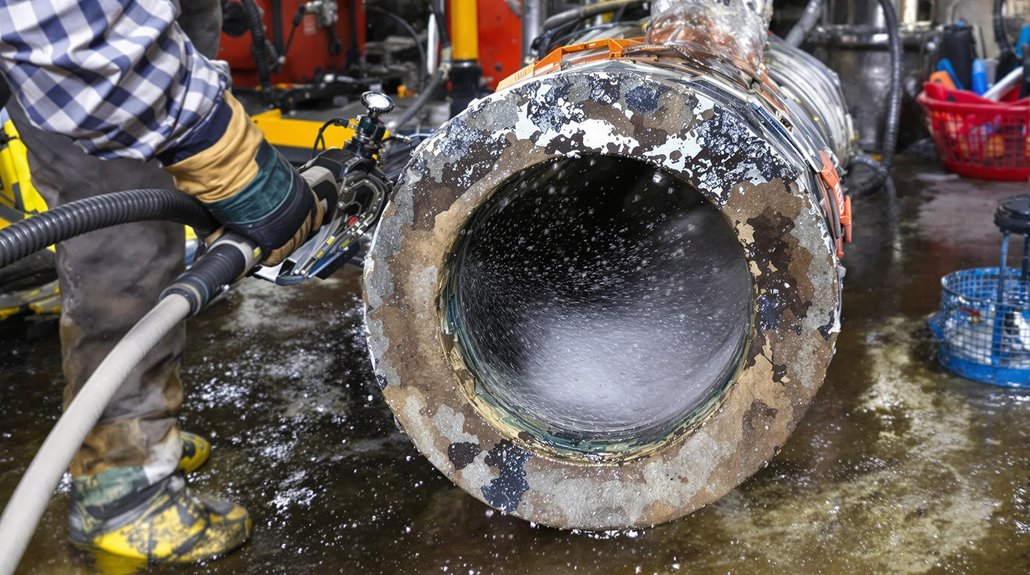
The Public Claims Adjusters Network (PCAN) operates as an extensive national organization of state-licensed public adjusters who have met rigorous vetting standards. Operating across 40+ states, PCAN members specialize in residential and commercial property damage claims, handling over 30 distinct claim types with professional expertise and ethical standards.
PCAN maintains strict quality control through:
- Annual audits of licenses and complaint records
- Intensive application and interview process for membership
- Mandatory adherence to highest ethical and professional standards
When property owners face the risk of damaging their insurance claims through improper handling, PCAN connects them with qualified experts happy to help navigate complex claim processes.
The network serves as a critical resource for policyholders seeking professional assistance, ensuring access to pre-vetted adjusters who maintain the highest industry standards.
These specialists undergo continuous monitoring to maintain their network membership, guaranteeing consistent quality service for all clients.
Frequently Asked Questions
How Do You Clear Blocked Sewage Pipes?
Professional pipe inspection techniques identify common blockage causes before implementing mechanical snaking, hydro-jetting, or enzyme treatments. Regular preventive maintenance tips include hot water flushing and biological cleaning solutions.
What Is the Best Way to Clean Waste Pipe?
Professional high-pressure jetting remains the ideal waste removal technique, supplemented by enzymatic pipe cleaning solutions. Regular maintenance using preventive strategies helps minimize buildup and maintains system efficiency.
How Much Does It Cost to Get a Sewer Line Cleaned Out?
Like maneuvering through financial waters, sewer line cleaning costs typically range $150-$500, varying by cleaning methods chosen. Advanced solutions like hydro jetting can reach $1,000, while cost factors include accessibility and severity.
Will Drano Unclog a Main Sewer Line?
Drano's effectiveness on main sewer lines is minimal and potentially damaging. Professional alternative unclogging methods like hydro jetting or mechanical snaking are necessary, as chemical cleaners can cause significant pipe damage.
